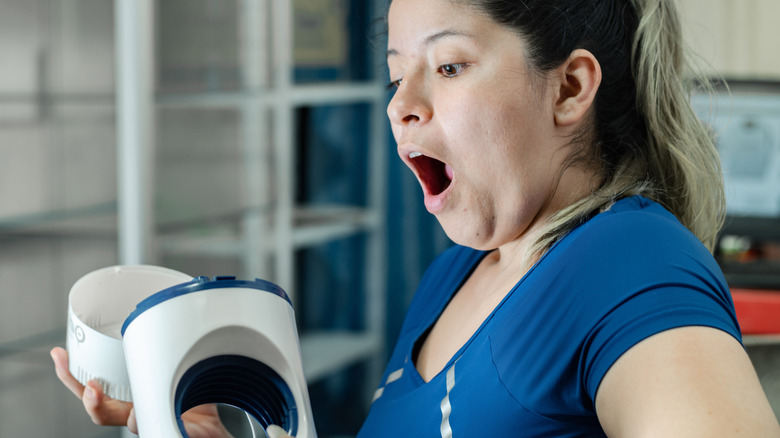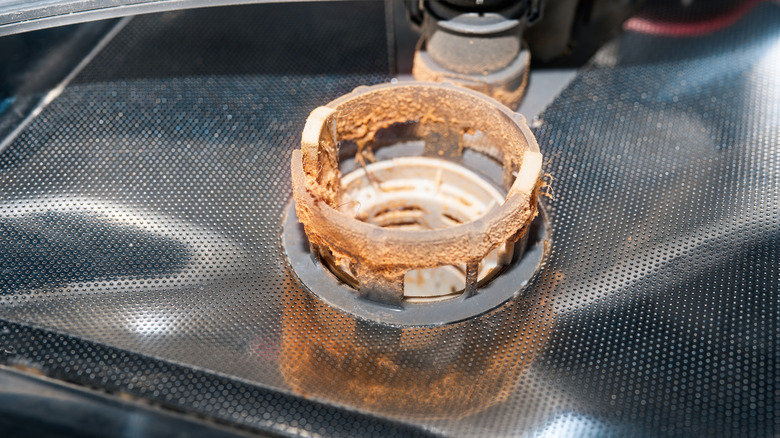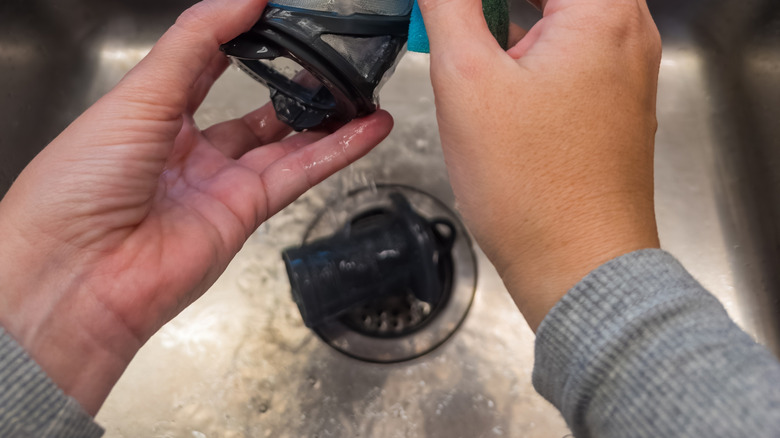Everyone Owns One And It's Secretly The Dirtiest Household Appliance
You trust one appliance above all others to sanitize the dishes and utensils your family uses every day. You probably run it nightly, or at least several times a week, assuming hot water and detergents leave it spotless — but the dishwasher is actually one of the dirtiest appliances in your home. If you want to know how to make your dishwasher run like new, you first need to understand why it gets dirty. Researchers who looked at dishwashers all over the world found that the rubber seals in over 60% of them were contaminated with fungi. The main concern was a type of black yeast called Exophiala dermatitidis that can easily survive the dishwasher's high heat and detergents.
The reason it's so dirty is because of the machine's environment. The warm, dark, and damp interior is the perfect breeding ground for microorganisms. The act of washing dishes introduces bits of food and grease, which collect in hard-to-reach areas and provide steady meals for unwanted microbes. This buildup of residue, combined with constant moisture, encourages bacteria and fungi to grow. The dishwasher then becomes a reservoir, ready to transfer these germs back onto dishes during the cleaning cycle, especially if the water temperature isn't hot enough.
What's really growing inside your dishwasher?
So, what are we really up against when figuring out how to clean and descale a dishwasher? The rubber seals, or gaskets, around the door are common gathering spots for bacteria. These areas trap moisture and food that the water jets can't reach, forming a layer of microbial film. Researchers from the University of Ljubljana released a study that showed one hundred percent of dishwashers tested contained some type of bacteria on these rubber seals. Scientists identified dozens of different species living inside dishwashers, including opportunistic pathogens. For example, bacteria such as Pseudomonas and Acinetobacter are commonly found on seals. They're usually harmless but can cause infections in people with weakened immune systems.
Fungi may be even better adapted to the dishwasher's harsh environment. A significant percentage of household dishwashers have various types of fungi, including molds and yeasts. Yeasts like Candida thrive on the detergent salts and high humidity inside the machine, sometimes using those ingredients to help them grow. Another concerning species is Exophiala dermatitidis, a black yeast known to survive in high heat and often associated with black mold growth. The fungus is tough and can cause severe infections, though this risk is highest for immunocompromised people. The presence of these microorganisms shows that detergent and hot water cycles alone are not always enough to keep the dishwasher sanitized.
How to clean a dishwasher filter, seal, and tub
One of the easiest ways to clean your dishwasher and the most overlooked step in maintenance is cleaning the filter. It's located underneath the bottom spray arm, and it catches the food debris that washes off during the cleaning cycle. A clogged filter causes dishes to come out dirty and creates the organic material where odor-causing bacteria multiply. The filter needs to be removed, soaked in hot, soapy water, and scrubbed with a brush to remove stuck-on grime before being placed back in the machine.
Aside from the filter, you need to address the door seal. To clean it, wipe around the seal with a soft brush or cloth dipped in a solution of 3 cups of hot water and ½ cup of white vinegar, then rinse well. After that, you can turn your attention to the inside of the dishwasher. Never run a cleaning cycle with bleach if your dishwasher has a stainless steel interior, since it will damage the finish.
A non-damaging option is white vinegar. Place one cup of white vinegar in an open, dishwasher-safe bowl on the top rack. Then run the machine through its hottest, empty cycle. Vinegar's acidity helps dissolve any limescale and mineral buildup where germs hide, and it naturally deodorizes the machine. After the cycle ends, open the door all the way to let the inside dry. Leaving the door ajar between uses is one of the best habits to stop mold and bacteria from growing, since it removes the moisture they need to thrive.


